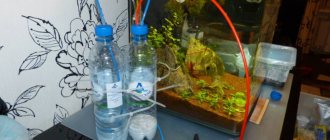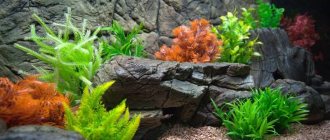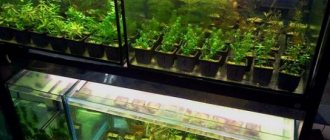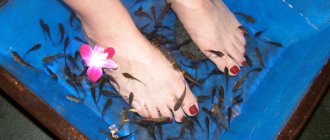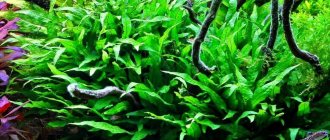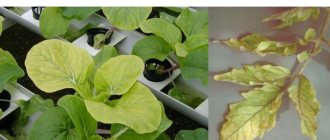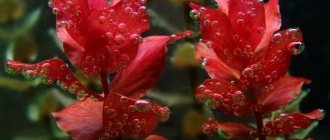It can be found in growing parts of the plant - buds, roots and on the tops of stems. It works like stem cells - not only other tissues and organs, but also a full-fledged plant can form from the meristem.
Plant propagation in vitro (in vitro) is now gaining great popularity, as it allows you to grow new varieties several times faster than with the traditional method. But since meristem cultivation is expensive and quite labor-intensive, rare or very capricious varieties are mainly propagated in this way.
Meristem reproduction
Reproduction of aquarium plants occurs by microcutting - a fragment of meristem tissue is placed in an absolutely sterile environment on the surface of a nutrient gel. There, cell division begins, from which full-fledged plants grow, complete copies of the mother plant.
The nutritional gel consists of sugars, phytohormones, amino acids and mineral salts. It is extremely important that the environment is sterile - its violation will provoke mold growth and plant death.
Using the meristem, you can recreate any part of the plant, which means that you can grow a large number of seedlings from just one healthy mother plant.
Laboratory cultivation should not be confused with genetic engineering. During meristem reproduction, no actions occur with genes; they remain in the same state that was intended by nature.
On average, the process of forming a new plant from cells lasts a month and a half. After this, it is microcutted to grow hundreds more new plants or transferred to a greenhouse complex. In the greenhouse, the plant has already grown to a size suitable for sale.
Initially, the meristem method of reproduction was used in agriculture and only recently became popular in the aquarium hobby.
Laboratory In Vitro
What do we do if we want to plant this or that plant on our site? Usually we buy seeds or ready-made seedlings for growing herbs and vegetables, seedlings for planting shrubs and trees, seedlings or bulbs for growing flowers. Do we often think about how the seedlings were obtained? It turns out that in addition to traditional cuttings, grafting, growing from seeds, propagation by rhizomes, bulbs, etc. In most countries, seedlings of many plants are now obtained by micropropagation. This method is especially widely used for growing plants that are difficult to propagate by other methods. This method is also indispensable if it is necessary to constantly obtain a significant amount of high-quality seedlings in a fairly short time.
Using microclonal propagation (another name for the method is meristem propagation), ornamental and fruit and berry plants, indoor and cut flowers, potatoes and other vegetables are grown.
Microclonal propagation of plants is widely used in the USA, Holland, Poland, France, Japan, and Thailand. Russia has also accumulated extensive experience in meristem propagation of plant species important for agriculture. Almost all Russian research institutes and breeding centers have established laboratories for microclonal propagation and improvement of breeding material. Relatively recently, meristem technologies began to be used by large plant nurseries and agricultural enterprises. In Russia, meristem technology has so far found its widest application in obtaining healthy potato seeds.
Planting in an aquarium
There is nothing difficult in planting microcloned plants, the main thing is to carefully think through the planting plan in advance.
Open the container with the plant immediately before planting. Bacteria and viruses can get into an open container, which will begin to rapidly develop in the nutrient gel and the sterility of the environment will be compromised.
Procedure for landing:
- Carefully remove the plant from the container. To do this, you can turn the container over and shake it a little or remove the material with tweezers. The less damage the aquarium plant receives, the easier the adaptation period will be. You can carefully move around the circle and pry the gel with tweezers - this will make it easier to remove it.
- Rinse the nutrient gel from the roots of the plant with warm running water. If the roots are too small, it is better to leave everything as it is; gel residues are not such a terrible problem as damaged roots.
- Trim the roots to a length of 1.5-2 cm. With long roots, the plant will only take longer to adapt to new conditions.
- Disassemble the material into separate parts. If you need to plant ground cover plants such as Hemianthus cubes, you can simply cut them with scissors.
- Prepare a hole in the soil and, using tweezers, place the plant there with the roots down, lightly pressing them with soil.
To make the plant endure the adaptation period easier, add a little liquid fertilizer.
Since ground cover plants have a weak root system, it is better to plant them as deep as possible, leaving a small area with leaves at the top. Such measures will not affect growth, but this way the plant will definitely not float up and die.
Planting potatoes
So, we waited for an acceptable temperature background, dug up the ground, prepared the holes, and all that remained was to place our tubers ready for exploits in them.
How deep should the hole be?
Analyze the indicators - the severity of the soil and the size of the tubers. The heavier the soil, the shallower the hole should be. The larger the tubers, the deeper they can be planted.
That is, you need to find some kind of compromise: so that the etiolated stem is long enough for a large number of stolons, but also so that your sprout copes with the task of breaking to the surface and turning into a nice green bush.
If these arguments seem too confusing to you, then let’s do this: the depth of the hole should be 5-15 cm.
A novice potato grower is tempted to place the tuber at the bottom of the hole so that the sprout stretches upward and turns into a green bush as quickly as possible.
But many people have heard somewhere that potatoes should be placed in the hole with the sprouts down, and now you will understand why:
- Firstly, of course, then the etiolated stem will have to go around the potato to get to the surface, it will be longer, and there will be more stolons.
- Secondly, and this is even more important, by placing the tuber with its sprouts down, you will plant it with its roots down - this is as logical as possible. Of course, if you put the tuber with its sprouts facing up, the plant will still survive, but, you see, it looks somehow strange and even inhumane on our part to plant it with its roots facing up?
When seedlings appear in your garden bed, it would be good to immediately hill them up. This will make it easier for the plant to grow additional roots - stolons and additional tubers.
When the bushes gain color - in the so-called budding phase - the plants will need abundant watering. During this period, tubers are formed. It is better to water the garden bed in the evening; you need to water the potatoes properly 5-7 times during the season.
A day after watering, the soil can be well but gently loosened.
That, in general, is all a novice vegetable grower needs to know about growing potatoes. Everything requires care, and the scheme of our childhood with two visits to the field over the summer does not work.
We hope that with this information we have saved you from rash actions and made your hope for a decent harvest a little more realistic. Good luck!
Advantages and disadvantages
Meristem aquarium plants have many advantages over ordinary ones:
- Lack of spores of other algae and snails. This is perhaps the most important difficulty that aquarists face when purchasing plants.
- Plants grown in the laboratory are absolutely healthy - they have no predisposition to viral, fungal and bacterial infections. Due to this, they do not require painstaking care and there is no risk that with new plants the aquarist will introduce an infection into a clean aquarium.
- Genetic uniformity. Plants grow identical to the mother's, which reduces to zero the likelihood of growing something unpredictable. During standard propagation of plants, varietal characteristics are split and young plants may completely lose their resemblance to their mother plants.
- Meristem aquarium plants can be propagated in the standard way directly in the aquarium.
- Convenient storage and transportation. Plants are packed in dense containers that can be transported for a long time. The main thing is to maintain a temperature of +5-+25°C. Without lighting, plants can be stored for 8-10 days, with normal lighting on a windowsill or table - up to 30 days.
- Compact packaging. A standard container holds as many sprouts as three traditionally grown pots.
Please note that at this time the aquarium plant is not just waiting for planting, but actively continues to grow!
Among the disadvantages, many aquarists note the long process of adaptation of the plant in the aquarium. But this process takes the same amount of time for ordinary plants grown in the traditional way.
Any plant needs time to adapt the metabolic process from the air to the aquatic environment and to form underwater leaves instead of air leaves. The main thing when replanting is to carefully wash off the nutrient with which the plant was transported and place it in a new environment as gradually as possible, ideally over several days.
How to find an approach to gentian?
I was especially interested in flowers, which I can’t grow myself. These include fragrant violet, dream grass, gentian and similar exquisite little things. Many times I tried unsuccessfully to get these flowers dear to my heart to sprout, sometimes I succeeded, but the success was not consolidated: the sprouts died in childhood. The gentian, the size of a thimble, bought at the market, did not survive either, and besides, it was not the freshest. The lumbago also suffered a sad fate, and I could not find a ready-made royal violet. And, imagine, in response to the question about the treasured, they showed me a sea of spring gentians: of different ages - from tiny little ones to three-year-olds covered with the first buds. It turned out that gentian is the favorite flower of the owner of the nursery herself, and she set herself the goal of overcoming the difficulties of propagation.
“I like to overcome difficulties,” says Inna Alexandrovna, “and growing gentian is incredibly difficult.” Especially the spring stemless one. Three years pass before the first flowering. The lumbago is also difficult to reproduce. These flowers are not even cloned. But the stemless thorny plant was only grown in a laboratory way.
-What a beautiful freak, how unusual! — Inna Alexandrovna admires, bending over a plant unfamiliar to me. “He doesn’t share, he can’t stand being transplanted.”
And violets grow here in abundance - there are white ones, and freckles, and that same one - the royal fragrant one. The variegated hellebore is in full bloom. I don’t even know what to ask anymore. “Meristem” has everything and more of what I heard and dreamed about. Incredible.
FAQ
Is it possible to plant a meristem in a new aquarium?
Experienced aquarists warn that in a problematic or clean aquarium, meristem plants may take root poorly and become overgrown with xenomena. If it already has an established balance, then the plant will quickly adapt to new conditions and begin to grow.
What types of plants do best?
Ammania bonsai, alternathera, eleocharis, anubis, proserpinacia, hygrophila, and pinnate have the best survival rate.
Why do you need to wash off the nourishing gel from the roots?
The nutrient substance with which the roots of the meristems are impregnated, after entering the aquarium, can become an ideal environment for the development of mold, fungi and bacteria.
How to choose the right plant?
Be sure to pay attention to the roots, they are clearly visible through the gel - due to improper transportation or storage conditions, they can rot and then the plant will simply die or be weakened.
It is also important to buy meristem aquarium plants only from official suppliers and carefully check the packaging - due to the popularity of this trend, many fakes have appeared on the market.
What is a meristem or “in vitro”
Experts call a meristem a plant tissue consisting of intensively dividing cells. They ensure the growth of the body and increase its mass.
The ability of meristem cells to actively divide is used to grow organisms from them that are identical to the original specimen. This process must take place in laboratory conditions under strict adherence to complete sterility. That’s why I call this method “in vitro”.
Meristem cells.
Its productivity is quite high. It allows you to obtain a large amount of genetically homogeneous material.
Orchid root structure
At first glance, different tribes of orchids have completely different roots. However, they all have the same structure . Let's go from the center to the edge:
- Axial cylinder;
- Endoderm;
- Bark;
- Exodermis;
- Velamen.
The structure of an orchid root.
The endoderm is a layer one cell thick that acts as a barrier. Exoderm - outer cells of the cortex that perform a protective function. Velamen is a group of dead cells where moisture moves through capillaries. In the cortex there are chloroplasts involved in photosynthesis and root growth, there is a meristem point at the tip.
You need to know this in order for the subsequent presentation to be more understandable.
Orchid resuscitation
Monopodial
There are cases when moisture that is not removed in time destroys the growing point. This can also occur as a result of a plant disease:
- Remove rot to healthy tissue;
- Treat the cut , preferably with undiluted Maxim, or sprinkle with a mixture of Alirin, Gamair, an antibiotic and a copper-based bactericide;
- Carefully pour the fungicide solution . It is necessary to water with the medicine for a month; if the bud wakes up earlier, water with a weak solution of fertilizer, alternating organic and mineral.
cytokine paste is used for stimulation , which is applied directly to the dormant kidney. It is not recommended to do this at the initial stage, because... the plant is weakened, instead of awakening, you can get the opposite effect.
Stimulation of the dormant point of the peduncle using cytokinin paste.
It is better not to replant the plant if it is clear that the roots are absolutely healthy, since the flower does not need additional stress. It is optimal to keep the orchid under a phytolamp. Keeping it on a windowsill is only possible in a shaded place, as far as possible from the glass.
The orchid should be watered when the substrate dries out and the roots turn silver. After the new shoot appears, even if the baby grows its own roots, there is no need to separate it from the mother plant, this will allow the orchid to reach flowering size faster.
Attention! It is in this situation that the illusion of growing an orchid from a root arises. In the absence of a functioning stem with a living dormant bud, this is impossible.
Sympodial
After an illness or improper care, an adult plant may be left with one pseudobulb without a piece of rhizome, i.e. there are nowhere to wait for roots, and there are no prizome buds either. And the orchid is beautiful, rare, beloved.
To ensure that your efforts are not in vain, you need to know which orchids can be restored from pruning, and which ones are not worth even trying.
Orchids in which the tuberidia are, as it were, divided into segments, surrounded by a thread belt on which dormant buds are located, are subject to restoration. Of the well-known tribes these are:
- Dendrobium;
- A group of Catasetums and Cichnodes, colloquially carrots;
- Cymbidiums;
- Sometimes Cattleya.
Cambrians, Coelogines and Lycastes can give birth to a new baby only from the crown bud, which happens extremely rarely.
There is no need to try to cut off a piece of pseudobulb to get another flower. By conducting such experiments, you can be left without a plant at all.
An orchid, indeed, is not a potato, and to restore it needs a lot of strength , which is concentrated in the tube. The larger the surviving piece of pseudobulb, the greater the chance of restoring the flower.
Resuscitation is carried out in the same way as described above using the example of Cattleya.



